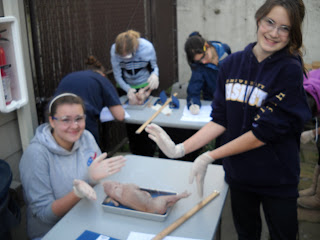Hello All,
On the Wednesday before break started we took our last field trip of 2009. We split up into three groups, each starting out at a different art exhibition. One group visited "Running The Numbers" by Chris Jordan at the Pacific Science Center. One group went to "The Old, Weird America" by various artists at the Frye and the third group went to "Yellow Terror" by Roger Shimomura at the Wing Luke Asian Museum. Each exhibit was unique and extremely conceptual.
Before heading out into the rainy morning, we had a few group activities at school. One involved standing in a large circle while a teacher in the middle of the circle read questions such as "Raise your arm if you have ever made a judgement or stereotype about someone," "Sit down if someone has ever asked to touch your hair." For the second activity we made a large "tic-tac-toe" board, but instead of X and O we wrote down our "identities." This included things like our values, ethnicity, relationships, important items, and plans for the future in the boxes we created. Then, as if under the wrath of an evil dictator, we had to "get rid" of the items written down or cross them off two at a time, so we were only left with two items remaining. Then, we anonymously handed in our paper and were off to catch the bus!
"Running The Numbers" focused on American consumption showing the value of material possessions and physical appearance. A few mind-boggling pieces include, an enormous "picture" of Benjamin Franklin. At a closer look, the photograph was actually made up of teeny-tiny $100 bills. Like all pieces, an additional plaque accompanying the work depicted what the image represented. The Ben Franklin photo represented the amount of money spent on the Iraq war every HOUR. Yikes! Other works included the number of recycled cell phones used in the US everyday, deaths from smoking per year in the US and inmates in America every year. The exhibit made the viewer think deeply about our society, our culture and how quick we are to throw away material possessions without thinking about the impacts.
The second exhibit, "The Old, Weird America" had a large variety of art. We focused on three particular pieces. The first was a life size double-sided rotating diorama of the traditional Thanksgiving story of the Pilgrims and Native Americans. One side showed the more well known Thanksgiving story, the Native Americans teaching the Pilgrims how to plant food, catch fish, and get along. The other side showed the less talked about and possibly more truthful side of the story. This time, the NA was kneeling on the ground, the Pilgrim getting ready to strike the Native American's back with a large stick. As you looked closer, a discreet, but shocking knife stabbed into the Native American's chest appeared. After spending a few minutes looking at the piece, our group had a short disscussion. We talked about the conflits between different values, cultures, societies, and classes. As with the other pieces we talked about the world behind the work of art (the artist's motivation, idea and background), the world in front of the work of art (how the piece made you feel, what it represents, and what it made you think about) and a visual inventory (describing the piece as well as materialistic choices the artist may have made).
The next piece we looked at was a large case covered with chicken wire. Inside were recreations of kitsch (objects thought to have poor taste, or being cheesy) dolls. In our group discussion, we talked about how the sculpture reminded us of a display case, or stereotypes and contradictions of Native American culture. Hanging on the walls next to the sculpture were large paintings/drawings of red and black graphic judgements and stereotypes made of Native American culture. There were cartoonist drawings of totem poles, people and Native American values that we discussed and found interesting, intriguing and thought provoking.
The third piece at "The Old, Weird America" exhibit that we looked at was a small statue depicting a young man who was about to step on a small house. Around the base of the platform the words read "Sacred Love and Pain." Because at a first glance this artwork was confusing our group found it necessary to read about the artists. We discovered that the work of art represented the two gay men's experiment. For almost fifteen years the two men lived as if they were in the early 20th century. This included what food they ate, how they dressed and they way the decorated their home. They wanted to see how hard it would have been for gay men living in an urban environment during that time period. In our group discussion, we talked about the facial expression of the figure (ignorance, frustration, oblivion) and that knowing the background of the artists helped us understand the artwork better.
The third and final art exhibit ("Yellow Terror") depicted the stereotypes and judgements of both the artist and Japanese culture during World War II. The artist, Roger Shimomura, used paintings of caricatures to express his ideas. There were postcards that had derogatory terms of Japanese people. There was one piece that had the iconic image of "Astro boy," but the artist had painted his face on the body. The painting represented how he had felt betrayed growing up with racist childhood super heros.
After spending an hour in the morning at each exhibit, we ate lunch, regrouped and headed out to see a different exhibit. The following morning, we met in our same groups from the previous day and discussed the artwork, had some time for reflection and shared the answers to questions we had reflected on.
Now returning from break we are ready to jump right into a fabulous new year! Heres to a great 2010!


